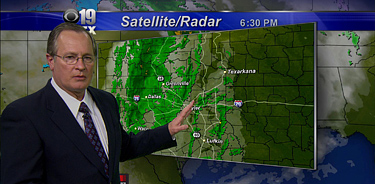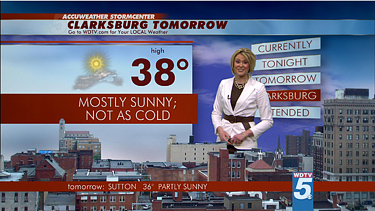Forecasting Weathercasting's Future Path
SAN FRANCISCO
In a constantly splintering market where stations must compete for viewers against other networks and mobile devices alike, local news has found a savior from the skies above.
With compelling graphics and realistically scalable landmarks, today's slate of weather graphics technology has helped stations boost ratings and capture viewers. But pretty pictures alone aren't enough. To keep viewers informed and engaged, weather graphics technology has to evolve with broadcaster's changing needs.
"The definition of what a weather graphic is has expanded," said Bob Baron Jr., chief products officer for Baron Services, a weather radar technology manufacturer. "A weather graphic is simply not what it used to be."

Today's HD weathercasting is far removed from the simple static maps that broadcasters used only a few years ago. Providing valuable weather solutions to viewers means recognizing the pivotal role weather plays in a local station's broadcast.
"Weather is becoming more and more part of the news, and as such, it should employ the same production process as news," said Ran Yakir, director of R&D for Vizrt. "Broadcasters need to consider whether weather tools can remain forever foreign to the production chain of a TV station, or whether they need to be properly integrated and share resources, by either sharing creative tools, mapping technologies, or production and playout techniques," he said.
When it comes to providing valuable weather information to viewers, broadcasters need to consider all the screens that their viewers access—not just broadcast television, but Web and mobile too—and to really program those screens in an effective manner.
"That means [to] think about each experience differently and not simply repurpose content that you've made for TV [and move it to] the digital platform," said Bill Dow, vice president of media product management for WSI Corp. "This all means [broadcasters] need to equip their people to produce more compelling content more quickly, and be able to react to breaking situations in real time on all platforms."
In some situations, that breaking news comes in the form of life-threatening hurricanes and tropical storms.
"[They're] both a forecasting challenge and a nationwide news opportunity," said Ryan Ayres, director of television operations for AccuWeather.
This is why an effective weather program needs ready-to-air graphics and information to support detailed storm reporting and data elements that can be quickly incorporated into a broadcast segment.
PROVIDING CONTENT FOR NEW VIDEO SERVICES
But viewers are no longer huddling around their television sets to get those frequent updates. Solutions have had to evolve over the last several years across the board to better address the latest round of mobile devices.
"Obviously one big trend [in the weather graphics market] is programming all screens effectively," WSI's Dow said. "Viewers expectations are different [when comparing] the HD screen and the mobile screen, and a station has to program each of these with that in mind."
NEW PRESENTATION TACTICS
The resulting rash of solutions to this big screen/small screen quandary is attempting to meet both of those needs: allowing content produced for an HD weather broadcast to be easily, and perhaps automatically, rebuilt for the Web or for mobile screens.
That means creating a broadcast-worthy experience that is far more than a simple textual weather update.
"The challenges for broadcasters will be to make sure the weather graphics on the mobile devices are maintaining the branding of the TV broadcast and are produced by a streamlined process, which is still part of the process of preparing a traditional weather broadcast," said Vizrt's Yakir. "This means that broadcasters need access to tools that allow them to share content and resources between various media types."
And it's not just the delivery device that's changed. Stations are also seeing weather content itself evolve. A growing number of producers are pulling in live weather pictures from IP and Web-based cameras from across their market area, which allows viewers to see the weather patterns changing in real time.
"Whether covering a traffic pile-up or severe weather event, live video integration enhances the stations' local coverage by enabling live reports from the scene, thereby giving viewers a live look at the weather as it is actually occurring," said Baron, whose company's Omni weather graphics engine allows up to 16 video sources to be pulled in at a time.
Stations are also incorporating more interactivity within their broadcasts. Orad Hi-Tec Systems' Interact allow a weather journalist to more easily interact with a touch screen, video wall or other input device. "Personalization enables broadcasters to use one system for multiple channels simultaneously, ensuring that their look and feel remains consistent throughout all their channels, while providing each channel the ability to display the weather data that is relevant to them," said Ofir Benovici, vice president of marketing for Orad.

New graphics packages allow weathercasters to include local landmarks and topology along with current conditions. The most recent slate of weather graphics technology has also given broadcasters additional precision when it comes to predicting weather. For example, by using pre-calculated weather data, Orad's 3DWeather is able to help stations create especially captivating graphics for their weather presentations.
Weather graphics have also pulled away from a one-size-fits-all scenario when it comes to showcasing a station's environs. Weather graphics technology now has the capability to create realistic looking local landmarks that can be tailored to an individualized interest.
REALISTIC LOCALISM
This availability to create 3D worlds means that resulting models must now instantly reflect changing weather conditions and provide photorealistic mapping at a snap. Some technologies have incorporated new types of graphics, such as swaying palm trees that move in relation to the wind, as well as local landmarks like stadiums and malls.
"Weather reporting tools have adopted real time 3D graphics, whereas in the past they were producing the weather show offline as clips and mainly in 2D," said Vizrt's Yakir.
Broadcasters are also investing in interactive devices like touchscreens and videowalls, creating weather reports that are controlled by the presenter in a more non-sequential way. This results in more complicated graphics engines with more comprehensive graphics.
"This creates a dramatic photorealistic environment that viewers, especially those on HD, expect from television and weather," said WSI's Dow, whose TruVu Max system is used to render live graphics on air with three-dimensional capabilities.
According to Joel Meyers, the founder and president of AccuWeather, the correct weather system mixes together key technologies, ingenuity and creativity.
That might mean a broadcaster should consider stepping out of the typical stand-and-point choreography of a normal gestured presentation using AccuWeather's SpaceCommand weather presentation, or by investing in new meteorological and graphics technology to improve on-air weather warnings, such as FirstWarn HD.
In the end, stations must keep a vigilant eye on where the future of broadcast weather could be headed, as hard as that future might be to predict.
"The goal is to get information on the air faster and connect with viewers in a different way," said Bill Boss, senior product manager for Weather Central. "You've got to leverage existing assets and resources, and make it easy to get user-generated content on the air."
Weather Central is taking that step, with its proprietary Web service ReportStorms.com. This technology allows users to view and create individual storm reports that can end up on the air, or may be used to pepper a Web site weather portal.
"The key is relying on high-quality, cost-saving products and services that leverage resources," Boss said.
The professional video industry's #1 source for news, trends and product and tech information. Sign up below.
Susan Ashworth is the former editor of TV Technology. In addition to her work covering the broadcast television industry, she has served as editor of two housing finance magazines and written about topics as varied as education, radio, chess, music and sports. Outside of her life as a writer, she recently served as president of a local nonprofit organization supporting girls in baseball.

